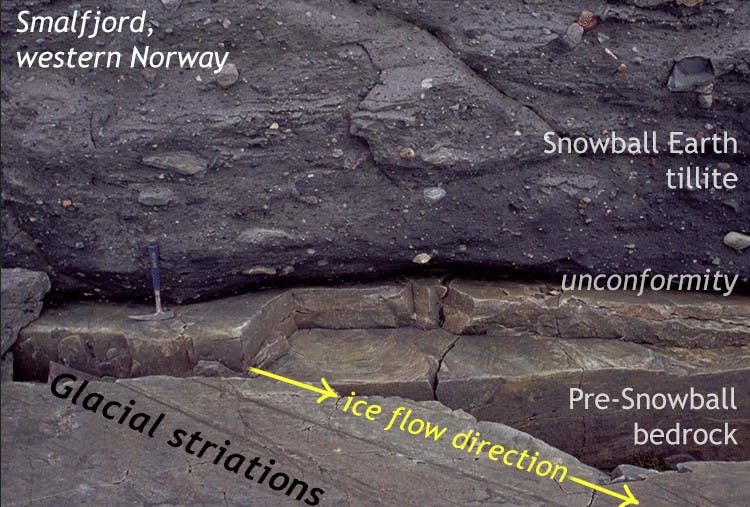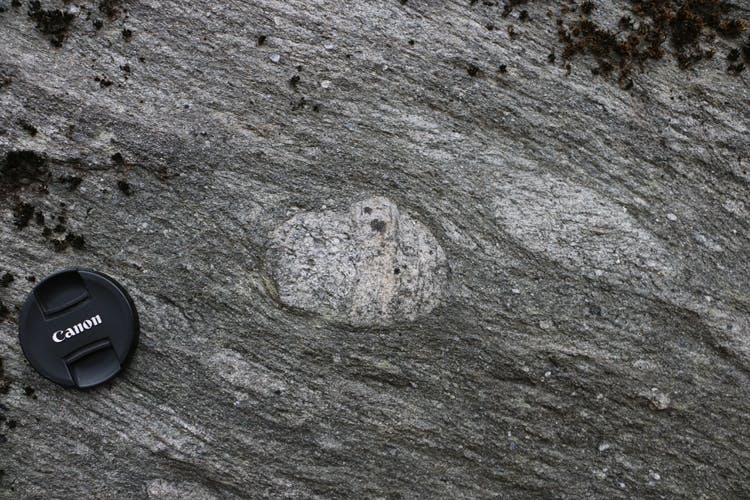
A TALE OF SNOWBALL EARTH IN THE NEOPROTEROZOIC ERA
Imagine a world entirely encased in ice, from pole to pole, with glaciers flowing even in the heart of the tropics. This may sound like a scene from a post-apocalyptic science fiction movie, but it’s a scenario that many geologists believe occurred not just once, but multiple times during Earth’s history, long before humanity walked the planet. Welcome to the fascinating story of “Snowball Earth” – a series of profound glaciations that gripped our world during the Neoproterozoic Era, between 1 billion and 541 million years ago.
DISCOVERING THE CLUES IN ANCIENT ROCKS
The idea of Snowball Earth first gained traction in 1992 when Caltech geophysicist Joe Kirschvink proposed that the entire planet might have frozen over during the Neoproterozoic. The name “Snowball Earth” stuck, and since then, scientists have been piecing together evidence from ancient rocks to understand the extent and timing of these remarkable glacial events.

Geologists have identified three main intervals of Snowball Earth glaciation: the Sturtian (720-660 million years ago), the Marinoan (645-640 million years ago), and possibly the Gaskiers or Ediacaran (around 580 million years ago). Among these, the Sturtian and Marinoan events are thought to have been the most severe. Evidence suggesting that glaciers reached sea level even at the equator.
“From a vantage point in outer space, the planet would have looked like a giant snowball,” Kirschvink quipped in his groundbreaking paper.
But how do scientists know that these extreme glaciations occurred so long ago? The answer lies in the rocks themselves, which bear distinctive signatures of ancient ice ages.
SCRATCHES, DIAMICTITES, AND DROPSTONES: THE FINGERPRINTS OF GLACIERS
When glaciers flow across the landscape, they leave behind telltale signs of their presence. One such sign is glacial striations – scratches or grooves carved into the bedrock by rocks embedded in the moving ice. These markings provide a clear indication of the direction in which the glacier was flowing. However, since they are subtle features that require a well-exposed bedrock surface to be visible, striations are the least common type of evidence for Snowball Earth glaciations.
More abundant are tillites and diamictites. They’re poorly sorted sedimentary deposits that contain a chaotic mix of large and small particles, from massive boulders to fine silt and clay. This “boulder clay” is a characteristic product of glacial erosion and transport. Its presence in Neoproterozoic rocks is a strong indicator of ancient ice ages.

For the Sturtian glaciation, tillites and diamictites have been documented at 39 locations across six continents, while the Marinoan event has left its mark at 48 sites worldwide.
Geologists can distinguish glacial diamictites, known as tillites, from other types of poorly sorted sediments. They do this by looking closely at the larger clasts within the deposit. In true tillites, some of these clasts will display faceted shapes with flat surfaces that have been ground down by being dragged along the base of the glacier. These facets often exhibit randomly oriented scratches, providing compelling evidence of glacial action.
DROPSTONE LAYERS
Another intriguing sign of Snowball Earth glaciations is the presence of dropstones in fine-grained marine sediments. Dropstones are pebbles, cobbles, or boulders that were transported out to sea by icebergs and dropped into soft sediment on the ocean floor as the ice melted. The impact of these falling stones disrupted the pre-existing sedimentary layers, creating truncated beds below and draped layers above the dropstone.
During the Neoproterozoic, when trees and canoes did not yet exist, floating ice is the only plausible way that large, isolated clasts could have been deposited in the deep sea. The abundance of dropstones in Neoproterozoic strata is thus a powerful indicator of extensive glaciation and iceberg rafting during Snowball Earth episodes.
UNRAVELING THE SNOWBALL STORY IN METAMORPHIC ROCKS
Not all rocks that formed during Snowball Earth times have remained in their original state. In some cases, mountain-building events have subjected these ancient glacial deposits to metamorphism – a process that transforms the rock under high temperatures and pressures. Geologists working in metamorphic terranes face an additional challenge in recognizing the signs of ancient glaciation, as the original sedimentary features may be obscured by later deformation and recrystallization.
Metamorphosed tillites and diamictites, known as metadiamictites, can be especially tricky to interpret. While they retain the characteristic poor sorting of their sedimentary precursors, metadiamictites also develop a foliated texture. This is due to the alignment of minerals during metamorphism. This foliation can wrap around the larger clasts in the rock. This creats a pattern that mimics the appearance of draped sedimentary layers over a dropstone.

To avoid misinterpreting metadiamictites, geologists must carefully examine the nature of the foliation and look for additional evidence of glacial influence, such as faceted and striated clasts. By unraveling the complex history recorded in these metamorphic rocks, scientists can still glean valuable insights into the extent and timing of Snowball Earth events.
IMPLICATIONS AND IMPORTANCE OF SNOWBALL EARTH
The concept of Snowball Earth has captivated the scientific community. This is not only because of the astounding nature of global glaciation but also due to its potential implications for the evolution of life on our planet. Some researchers have suggested that the extreme environmental stresses imposed by these prolonged ice ages may have served as a catalyst. This might explain the development of complex multicellular organisms during the Ediacaran Period which followed the last Snowball event.
Understanding the mechanisms that drove the Earth into and out of these extraordinary glacial states can also provide valuable insights into the complex interplay between our planet’s atmosphere, oceans, and biosphere. By studying the Snowball Earth episodes, scientists can better comprehend the feedbacks and tipping points within the Earth system that can lead to abrupt and dramatic climate changes.
Moreover, the evidence for Snowball Earth glaciations has important ramifications for our search for life beyond our planet. If Earth could recover from such extreme global freezing events and eventually give rise to the incredible diversity of life we see today. This suggests that other planets might also be capable of harboring life even if they have experienced similar episodes of global glaciation.
THE DAWN OF A NEW ERA
As the last ice sheets of the Marinoan glaciation receded around 640 million years ago, the Earth emerged from the grips of Snowball conditions and entered a new chapter in its history. The Ediacaran Period, which followed, witnessed an explosion of new life forms. This included the first complex multicellular organisms visible to the naked eye.
While the exact causes and consequences of Snowball Earth events remain a subject of ongoing research and debate. The evidence preserved in ancient rocks paints a compelling picture of a world dramatically different from the one we know today. Through the lens of geology, we can marvel at the resilience and adaptability of our planet. Earth has weathered countless crises and transformations throughout its long history.
As we continue to explore the mysteries of Earth’s past, the story of Snowball Earth serves as a reminder of the intricate web of interactions that shape our world. It shows us the importance of understanding these complex systems as we navigate the challenges of the present and future. The tale of global glaciation during the Neoproterozoic may be a distant one, but its echoes resonate through the rocks beneath our feet, inviting us to ponder the incredible journey that has led us to where we stand today.



